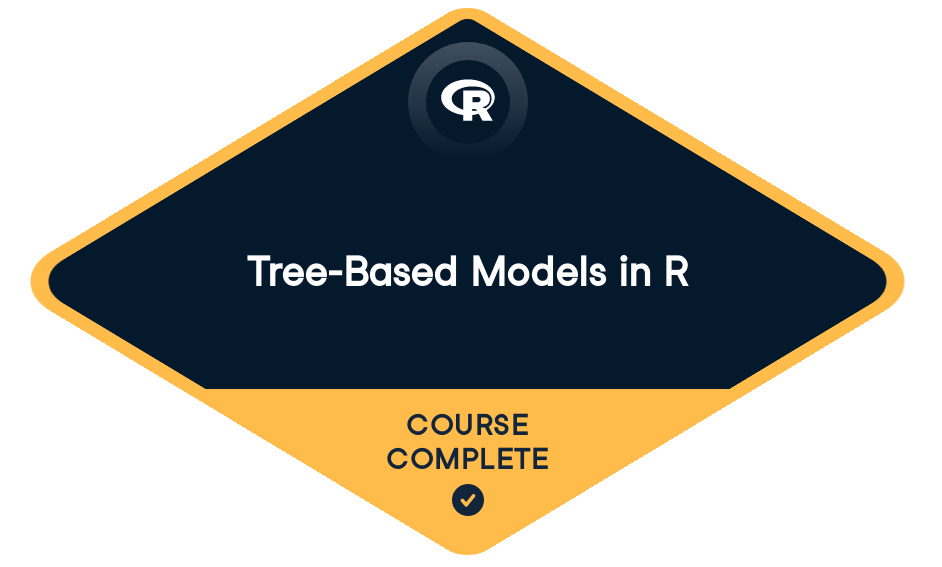
Loved by learners at thousands of companies
Course Description
In this course you'll learn how to work with tree-based models in R. This course covers everything from using a single tree for regression or classification to more advanced ensemble methods. You'll learn to implement bagged trees, Random Forests, and boosted trees using the Gradient Boosting Machine, or GBM. These powerful techinques will allow you to create high performance regression and classification models for your data.
For Business
Training 2 or more people?
Get your team access to the full DataCamp library, with centralized reporting, assignments, projects and more- 1
Classification Trees
FreeThis chapter covers supervised machine learning with classification trees.
Welcome to the course!50 xpBuild a classification tree100 xpIntroduction to classification trees50 xpAdvantages of tree-based methods50 xpPrediction with a classification tree50 xpOverview of the modeling process50 xpTrain/test split100 xpTrain a classification tree model100 xpEvaluating classification model performance50 xpCompute confusion matrix100 xpSplitting criterion in trees50 xpCompare models with a different splitting criterion100 xp - 2
Regression Trees
In this chapter you'll learn how to use a single tree for regression, instead of classification.
Introduction to regression trees50 xpClassification vs. regression50 xpSplit the data100 xpTrain a regression tree model100 xpPerformance metrics for regression50 xpEvaluate a regression tree model100 xpWhat are the hyperparameters for a decision tree50 xpTuning the model100 xpGrid search for model selection50 xpGenerate a grid of hyperparameter values100 xpGenerate a grid of models100 xpEvaluate the grid100 xp - 3
Bagged Trees
In this chapter, you will learn about Bagged Trees, an ensemble method, that uses a combination of trees (instead of only one).
Introduction to bagged trees50 xpAdvantages of bagged trees50 xpTrain a bagged tree model100 xpEvaluating the bagged tree performance50 xpPrediction and confusion matrix100 xpPredict on a test set and compute AUC100 xpUsing caret for cross-validating models50 xpCross-validate a bagged tree model in caret100 xpGenerate predictions from the caret model100 xpCompare test set performance to CV performance100 xp - 4
Random Forests
In this chapter, you will learn about the Random Forest algorithm, another tree-based ensemble method. Random Forest is a modified version of bagged trees with better performance. Here you'll learn how to train, tune and evaluate Random Forest models in R.
Introduction to Random Forest50 xpBagged trees vs. Random Forest50 xpTrain a Random Forest model100 xpUnderstanding Random Forest model output50 xpEvaluate out-of-bag error100 xpEvaluate model performance on a test set100 xpOOB error vs. test set error50 xpAdvantage of OOB error50 xpEvaluate test set AUC100 xpTuning a Random Forest model50 xpTuning a Random Forest via mtry100 xpTuning a Random Forest via tree depth100 xp - 5
Boosted Trees
In this chapter, you will see the boosting methodology with a focus on the Gradient Boosting Machine (GBM) algorithm, another popular tree-based ensemble method. Here you'll learn how to train, tune and evaluate GBM models in R.
Introduction to boosting50 xpBagged trees vs. boosted trees50 xpTrain a GBM model100 xpUnderstanding GBM model output50 xpPrediction using a GBM model100 xpEvaluate test set AUC100 xpGBM hyperparameters50 xpEarly stopping in GBMs100 xpOOB vs CV-based early stopping100 xpModel comparison via ROC Curve & AUC50 xpCompare all models based on AUC100 xpPlot & compare ROC curves100 xp
For Business
Training 2 or more people?
Get your team access to the full DataCamp library, with centralized reporting, assignments, projects and moreErin L.
See MoreChief Machine Learning Scientist at H2O.ai
Gabriela de Queiroz
See MoreData Scientist and founder of R-Ladies
Join over 13 million learners and start Tree-Based Models in R today!
Create Your Free Account
or
By continuing, you accept our Terms of Use, our Privacy Policy and that your data is stored in the USA.
